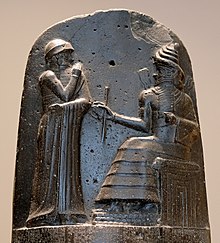
Back Hammoerabi Afrikaans Hammurapi ALS ሃሙራቢ Amharic حمورابي Arabic حمورابى ARZ Hammurabi AST Hammurapi Azerbaijani حمورابی AZB Хаммурапи Bashkir Hamurabis BAT-SMG
| Hammurabi 𒄩𒄠𒈬𒊏𒁉 | |
|---|---|
| King of Babylon King of the Four Corners of the World | |
 | |
| King of the Old Babylonian Empire | |
| Reign | c. 1792 – c. 1750 BC (MC) |
| Predecessor | Sin-Muballit |
| Successor | Samsu-iluna |
| Born | c. 1810 BC Babylon |
| Died | c. 1750 BC (aged 59–60) Babylon |
| Issue | Samsu-iluna |
Hammurabi (/ˌxæmʊˈrɑːbi/; Akkadian: 𒄩𒄠𒈬𒊏𒁉 Ḫâmmurapi;[a] c. 1810 – c. 1750 BC), also spelled Hammurapi,[3][4] was the sixth Amorite king of the Old Babylonian Empire, reigning from c. 1792 to c. 1750 BC. He was preceded by his father, Sin-Muballit, who abdicated due to failing health. During his reign, he conquered the city-states of Larsa, Eshnunna, and Mari. He ousted Ishme-Dagan I, the king of Assyria, and forced his son Mut-Ashkur to pay tribute, bringing almost all of Mesopotamia under Babylonian rule.
Hammurabi is best known for having issued the Code of Hammurabi, which he claimed to have received from Shamash, the Babylonian god of justice. Unlike earlier Sumerian law codes, such as the Code of Ur-Nammu, which had focused on compensating the victim of the crime, the Law of Hammurabi was one of the first law codes to place greater emphasis on the physical punishment of the perpetrator. It prescribed specific penalties for each crime and is among the first codes to establish the presumption of innocence. They were intended to limit what a wronged person was permitted to do in retribution. The Code of Hammurabi and the Law of Moses in the Torah contain numerous similarities.
Hammurabi was seen by many as a god within his own lifetime. After his death, Hammurabi was revered as a great conqueror who spread civilization and forced all peoples to pay obeisance to Marduk, the national god of the Babylonians. Later, his military accomplishments became de-emphasized and his role as the ideal lawgiver became the primary aspect of his legacy. For later Mesopotamians, Hammurabi's reign became the frame of reference for all events occurring in the distant past. Even after the empire he built collapsed, he was still revered as a model ruler, and many kings across the Near East claimed him as an ancestor. Hammurabi was rediscovered by archaeologists in the late nineteenth century and has since been seen as an important figure in the history of law.
- ^ Roux 1992, between 266–267.
- ^ Millard 2004.
- ^ Khwshnaw 2023.
- ^ Hone, Charles F. (1917). . Vol. 1 – via Wikisource. [scan
 ]
]
Cite error: There are <ref group=lower-alpha> tags or {{efn}} templates on this page, but the references will not show without a {{reflist|group=lower-alpha}} template or {{notelist}} template (see the help page).
© MMXXIII Rich X Search. We shall prevail. All rights reserved. Rich X Search